Oued Fes
The Oued Fes (Arabic: واد فاس, lit. 'River of Fes') is a river in Morocco. It is a tributary of the Sebou River and historically the main source of water for the city of Fes, after which it is named.
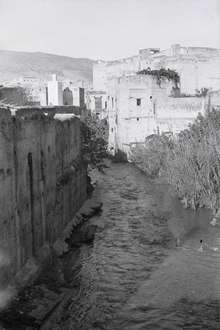
The river consists of a number of different streams which originate in the Saïss Plain to the south and west of Fes before joining together in the area of Fes el-Bali, the old city (medina) of Fes.[1][2] Over the centuries the river has been split and diverted into a multitude of canals that distributed water across the city and once powered a number of historic waterwheels.[1][3] These various water channels converge into the Oued Bou Khareb which runs through the middle of the old city and historically divided the Qarawiyyin and Andalusiyyin quarters.[1] After the river leaves the city it runs eastwards for a short distance before joining the Sebou River. The various branches and sections of the river, including many of the man-made canals, also have their own names.
Source
The river begins at Ras al-Ma ("Head of the Water"), 12 kilometres southwest of the city, from a hollow of lacustrine limestone, with an approximate flow of 500 litres/second.[4]:131
Oued al-Jawahir
.png)
The main branch of the river skirts the northern edge of the Royal Palace grounds (the Dar al-Makhzen) and of Fes el-Jdid before entering Fes el-Bali. This section is also known as the Oued al-Jawahir (Arabic: واد الجواهر, lit. 'River of Pearls').[1] It once passed through a flat area of marshes and wetlands located near what is now Fes el-Jdid and the modern Ville Nouvelle, before emerging at a number places.[5] However, since the founding of Fes el-Jdid (13th century), the Oued al-Jawahir was progressively diverted and some of its old streams seem to have disappeared.[5] The river's flow was re-engineered to provide water for the Royal Palace complex and a succession of royal gardens such as the Mosara Gardens of the Marinids (now disappeared) and the 19th-century Jnan Sbil Gardens (still extant), before continuing towards Fes el-Bali, where it is distributed across an extensive network of man-made streams and canals.[2][1]
The historic water network of Fes el-Bali
Fes el-Bali's extensive water network predates the foundation of Fes el-Jdid. Its current outlines were begun by the Zenata emir Dunas ibn Hamama between 1137 and 1049, and then further elaborated by the Almoravid emir Yusuf ibn Tashfin between 1069 (the Almoravid conquest of Fes) and 1106.[4][3] From the west, the Oued al-Jawahir flows eastward along the northern edge of Fes el-Jdid, passing through the Bab Bou Jat Mechouar, through the Dar al-Makina (a former arms factory), and then beneath the Old Mechouar near Bab Dekkakin before reemerging on its eastern side, on the edge of the Jnan Sbil Gardens. Here it emerges from four arched openings at the bottom of the Old Mechouar's ramparts and the first major man-made division of the river take place.[4] This division creates a number of canals (many of them hidden under streets and houses) through Fes el-Bali which eventually spill back into the Oued Bou Khareb (the name of the river's main course inside the city).[4][1] There are four main historic canal divisions: the Oued Fejjalin, the Oued el-Hamiya, the Sakiyyat el-Abbasa, and the Oued Shrashar.[1] Most of these then split off into other canals as they progress through the city.
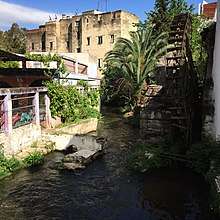
The Oued Fejjalin is one of the most important divisions and from it the Oued el-Lemtiyyin also splits off to supply the northernmost parts of the city.[4][1] The Oued el-Lemtiyyin passes under the Bou Jeloud area and travels under the houses of Tala'a Kebira street until it reaches the Bou Inania Madrasa.[4] Here, in the vicinity of the madrasa, the water is collected by a large distributor structure made of brick and rammed and dating from the Almoravid period. This structure has three arched openings that lead into vaulted chambers from which the water emerges on the other side into three canals at different elevations, which then spread across different parts of the northern city.[4][3]
As for the Oued el-Hamiya, it splits from the other major branches at Jnan Sbil before dividing into more branches which mostly supply the southern parts of the city.[4] One of its branches also once supplied, via an aqueduct, the Andalus quarter on the opposite shore of the Bou Khareb river.[1] (Most of the water for the Andalus quarter, however, came from a canal which originated from other streams to the south of instead of the Oued al-Jawahir; see "Oued Masmuda" section below.) The two last branches, Sakiyyat al-Abbasa and the Oued Shrashar, supplied the regions near Bab al-Hadid and the gardens between Fes el-Jdid and Fes el-Bali.[1]
Many of these canals are now underground, with only some ancient toponyms hinting at former bridges that passed over them (e.g. the name Qantrat Bou Rous along a part of Tala'a Kebira).[1] These canals and streams also feed a number of industries such as the historic tanneries of the city, the most famous of which are the Chouara Tanneries.[1] A large number of waterwheels (known as norias or sometimes as saqiyyas) were located throughout the city's water network in order to assist in water distribution or to power certain industries.[1][4] Some of these were very large, such as the huge noria which supplied the Marinid royal gardens of Mosara, measuring 26 meters in diameter and 2 meters in thickness.[2] Only a few of these waterwheels have survived in some form, including some examples around the Jnan Sbil Gardens.[1][3]
Oued Bou Khareb
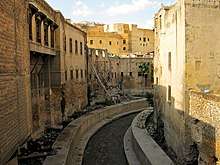
Oued Bou Khareb (or sometimes Oued el-Kbir) is the usual name given to the main urban course of the river through the middle of Fes el-Bali.[1]:122 This river is initially fed by two other streams called the Oued ez-Zitoun and the Oued Bou Fekran that enter the city from the south at Bab Jdid.[1]:234 It is also fed by the various canals that split off from the Oued al-Jawahir to supply the city before eventually ending up in this ravine in the middle of the city. As the lowest point in the medina, the river thus acts as a collector for the city's used water.[4][3]
The course of the Bou Khareb also forms the historical boundary between the Qarawiyyin and Andalus quarters of the city, which were originally two separate cities (al-'Aliya and Madinat Fas) in their early history before being joined together by the Almoravids in the 11th century.[1] Much of the Oued Bou Khareb's course, from Bab Jdid to Place R'cif, is now hidden beneath a modern road for car traffic (one of the few that penetrates the medina). The road covers the river up to Place R'cif, a large square at the heart of the medina, and the river reemerges on the north side of square.[2][1] From there the river runs northeast and exits the city between Bab Guissa and the former gate of Bab Sidi Bou Jida.[1]
Oued Masmuda
The streams to the south of the city which formed the beginning of the Bou Khareb river also fed another important canal called Oued Masmuda.[1] This canal, slightly further east, supplied water for most of the Andalus quarter of Fes on the southeast side of the Bou Khareb river.[1][4] It begins to the south of the city and passed through the old city walls through a culvert opening called Bab ash-Shobbak ("Gate of the Window") which was protected by an iron grille.[4][1] A few other canals split from it as it wound its way through the city, until it finally rejoined the Bou Khareb river shortly before its exit from the city.[1][4] The canal appears to be named after the Masmuda Berber tribal confederacy that founded the Almohad movement, which suggests that it might have been constructed by the Almohads or that Masmuda families or troops were housed near it at some point.[1]:113
Historic Bridges over the Bou Khareb
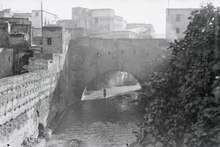
The Oued Bou Khareb is crossed by several historic bridges inside the medina, some of which were first built before the unification of the two shores into a single city in the 11th century.[6] There were once at least six bridges, reportedly built by the Zenata emir Dunas ibn Hamama in the early 11th century, before the unification of the two cities by the Almoravids later in the same century.[7][1][6] Other scholarly sources, however, attribute at least some of the bridges to the Almoravid period (late 11th to early 12th centuries) when the two early cities of Fes were unified.[3] Many of them were destroyed in subsequent floods in the early 14th century, and only some of them were rebuilt by the Marinid Sultan Abu Sa'id at the time.[7]
Of the bridges that remain today, the Qantra Bin el-Moudoun ("Bridge Between the Two Cities") is the northernmost of them, followed to the south by the Qantrat Sebbaghin ("Bridge of the Tanners") and by the Qantrat Terrafin ("Bridge of the Cobblers") just north of Place R'cif. Another bridge, the Bridge of Sidi al-'Awwad, was located further south but likely disappeared during the 20th century when the river was covered by the modern paved road.[1] The Bin el-Moudoun Bridge, believed to date from the time of Emir Dunas ibn Hamama, was considered one of the most picturesque, being located amidst a stretch of rocky rapids.[5][7] It has a span composed of three arches but only the central one is still visible today.[3] The Sebbaghin Bridge, also known as the Khrashfiyin Bridge (or Khrachfiyine in the French transliteration), is believed to have been originally built by Emir Dunas and restored or rebuilt by the Marinids in the 14th century.[6][7] The Terrafin bridge, originally named Qantrat Bab al-Silsila and now found on the northern edge of Place R'cif, is also believed to date initially from Emir Dunas in the 11th century.[6][3][7] It is notable for having been lined with shops on both sides, a feature still visible in its structure today.[3][1]
Pollution problems and rehabilitation efforts
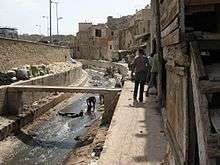
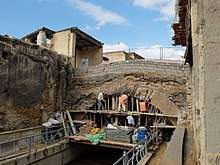

The river, particularly the Oued Bou Khareb within the old medina, had long suffered from heavy pollution due to sewage, the activities of the nearby tanneries (which generate chemical waste), and to being used as a dumping ground by residents.[8][9] Even the name Oued Bou Khareb means "River of Trash".[1][8] In recent times the city authorities had begun covering the exposed parts of the river with concrete slabs, which only led to more garbage piling up.[9]
In the late 2000s, a large-scale project to rehabilitate the river system and its urban environment was begun. The project, led by architect Aziza Chaouni, included the cleaning up of the river, the renovation of its urban shoreline, the creation of open pedestrian walkways, and the renovation of existing open spaces along the river such Place R'cif and Place Lalla Yeddouna.[8][9][10] The proposal to improve water quality also included the creation of wetlands (which had previously existed along the river's course) and the restoration of the river's canals.[9]
The rehabilitation of the river, which has been underway since, also took place alongside broader efforts to restore the historical monuments and landmarks of the old city, mostly under the direction of the local heritage restoration agency ADER-Fes. This included the restoration of the bridges over the Bou Khareb river, with the Terrafin and Sebbaghin/Khrashfiyin bridges being restored in the 2010s.[6]
References
| Wikimedia Commons has media related to Oued Bou Khareb. |
- Le Tourneau, Roger (1949). Fès avant le protectorat: étude économique et sociale d'une ville de l'occident musulman. Casablanca: Société Marocaine de Librairie et d'Édition.
- Métalsi, Mohamed (2003). Fès: La ville essentielle. Paris: ACR Édition Internationale. ISBN 978-2867701528.
- Marcos Cobaleda, Maria; Villalba Sola, Dolores (2018). "Transformations in medieval Fez: Almoravid hydraulic system and changes in the Almohad walls". The Journal of North African Studies. 23 (4): 591–623.
- Madani, Tariq (1999). "Le réseau hydraulique de la ville de Fès". Archéologie islamique. 8–9: 119–142.
- Gaudio, Attilio (1982). Fès: Joyau de la civilisation islamique. Paris: Les Presse de l'UNESCO: Nouvelles Éditions Latines. ISBN 2723301591.
- "La magnifique rénovation des 27 monuments de Fès – Conseil Régional du Tourisme (CRT) de Fès" (in French). Retrieved 2020-03-31.
- Gaillard, Henri (1905). Une ville de l'Islam: Fès. Paris: J. André. pp. 32.
- "Revitalization of the Fez River: A Reclaimed Public Space | Smart Cities Dive". www.smartcitiesdive.com. Retrieved 2020-03-31.
- "Morocco.com | The Rejuvenation of the Fez River". www.morocco.com. Retrieved 2020-03-31.
- "Aziza Chaouni presents a 2014 TED Talk on her efforts to uncover the Fez River in Morocco". Daniels. 2014-03-20. Retrieved 2020-03-31.